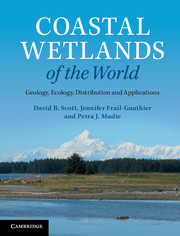Book contents
- Frontmatter
- Contents
- Preface
- List of acronyms and abbreviations
- 1 Introduction: what is covered in this coastal wetlands book?
- 2 Physical aspects: geological, oceanic and climatic conditions
- 3 Zonations and plants: development, stressors and adaptations
- 4 Animals in coastal wetlands: zonation, adaptations and energy flow
- 5 Human intervention causing coastal problems
- 6 Coastal wetlands worldwide: climatic zonation, ecosystems and biogeography
- 7 Examples of North American salt marshes and coastal wetlands
- 8 Examples of South American coastal wetlands
- 9 Africa: selected marsh and mangrove areas
- 10 Europe and Asia: a view of what remains
- 11 Australasia: wetlands of Australia and New Zealand
- 12 Applications in geological monitoring: paleoseismology and paleoclimatology
- 13 Applications in conservation of plant biodiversity and agriculture
- 14 Using mesocosms as a way to study coastal wetlands
- 15 Conclusions and future directions
- References
- Index
- Plate section
1 - Introduction: what is covered in this coastal wetlands book?
Published online by Cambridge University Press: 05 July 2014
- Frontmatter
- Contents
- Preface
- List of acronyms and abbreviations
- 1 Introduction: what is covered in this coastal wetlands book?
- 2 Physical aspects: geological, oceanic and climatic conditions
- 3 Zonations and plants: development, stressors and adaptations
- 4 Animals in coastal wetlands: zonation, adaptations and energy flow
- 5 Human intervention causing coastal problems
- 6 Coastal wetlands worldwide: climatic zonation, ecosystems and biogeography
- 7 Examples of North American salt marshes and coastal wetlands
- 8 Examples of South American coastal wetlands
- 9 Africa: selected marsh and mangrove areas
- 10 Europe and Asia: a view of what remains
- 11 Australasia: wetlands of Australia and New Zealand
- 12 Applications in geological monitoring: paleoseismology and paleoclimatology
- 13 Applications in conservation of plant biodiversity and agriculture
- 14 Using mesocosms as a way to study coastal wetlands
- 15 Conclusions and future directions
- References
- Index
- Plate section
Summary
Coastal wetlands, including tidal salt marshes and mangrove swamps, are environmentally stressful and variable habitats, and yet are teeming with life. Their biological productivity exceeds that of coral reefs and matches that of tropical rainforests. These wetlands provide resident plants and animals with shelter, food and continuous renewal of nutrients on each tidal cycle. These coastal wetlands are also vital to neighbouring ecological communities and have important values to humans, serving as natural carbon-capture systems, as sources of oceanic ‘blue carbon’, as filters of sediment or nutrient-loaded flood water and as buffers against storm tides and rising sea levels. Concern about the twentieth-century destruction of many wetlands in North America, Europe, Australia and New Zealand, and the degradation of wetlands worldwide led to the 1971 Ramsar Convention on Wetlands, held on the shore of the Caspian Sea in Iran (see Box 1.1 The Ramsar Convention). The Convention provides foundations for planning of ‘wise use’ for all wetlands; preservation of wetlands with international importance for ecology, biodiversity or hydrology; and co-operative protection of internationally shared species. Coupled with this landmark environmental agreement, the United Nations designated 2 February as ‘World Wetlands Day’, bracketing it with programmes to raise awareness of the strong link between global freshwater supplies and wetland resources. These two themes ‘Water’ and ‘Wetlands’ highlight global efforts to promote understanding that without coastal wetland conservation, there will not be enough water for sustainable development, human health and, ultimately, the survival of humankind.
- Type
- Chapter
- Information
- Coastal Wetlands of the WorldGeology, Ecology, Distribution and Applications, pp. 1 - 4Publisher: Cambridge University PressPrint publication year: 2014



